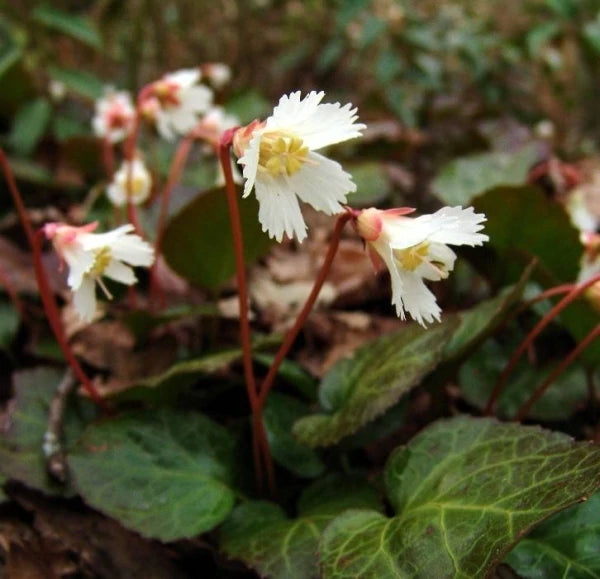The genus Shortia may be small in size but it is large on charm and has an amazing story of discovery, loss, and re-discovery that spans 100 years and involves two famous plant explorers. There are just 6 species (all rare) in genus Shortia and one of those (the very rare S. galacifolia) is a North Carolina native plant and lives in the Appalachain mountains.
No products found
Shop our current offerings
More Information About Shortia
Shortia plants spread slowly via runners and live in cool, humid, deeply shaded areas. Thus, Shortia is a great groundcover for the woodland garden. In the wild, Shortia lives under the shade of Rhododendrons and Magnolias on streambanks and slopes at the base of mountains in high rainfall areas, and that gives us clues to its preferred garden conditions...rich, acidic, well drained soil, with plenty of moisture and shade. Although very rare, Shortia transplants well and is not particularly hard to grow. The only thing keeping Shortia from wider use is its difficult and lengthy propagation, which prevents many nurseries from growing it.
Shortia flowers are charming with small pinkish sepals and white, toothed petals. The plants themselves are evergreen perennials with lovely, shiny, leathery leaves that turn a nice reddish color during the winter.
The North American species, Shortia galacifolia, is famous for being discovered, then lost, then rediscovered. In 1788, the famed French plant explorer Andre Micheaux discovered Shortia galacifolia growing in South Carolina near the confluence of the Toxaway and Whitewater rivers (now buried under Lake Jocassee) in Oconee county. Micheaux could not identify the small plant and he sent a dried, pressed specimen with a single fruit and no flowers to a plant library (herbarium) in Paris. There, the lonely sample sat on a dusty shelf for 51 years until re-discovered in 1839 by the renowned American botanist, Asa Gray, who had travelled to Europe to study Micheaux's American plant collections.
Gray realized that the sample represented a brand new genus and named it Shortia after his amateur botanist buddy, Dr. Charles Wilkins Short of Kentucky. The species epithet galacifolia was given after the resemblance of the leaf to members of the genus Galax. Gray and other botanists became obsessed with finding S. galacifolia alive in its native habitat and spent more than 40 years searching for the plant but only met with failure. Shortia became something of a holy grail of the plant world and other famous botanists of the era (Torrey, Sargent) also failed to located the elusive plant. Then in 1877, a 17-year old plant-hunter, George Hyams, rediscovered the plant on the banks of the Catawba river in McDowell county, NC.
Shortia belongs to a small and esoteric family of plants called Diapensiaceae. We also have a few of its relatives growing in our garden, namely Berneuxia, Galax and Pyxidanthera. Shortia is more distantly related (order Ericales) to more popular garden perennials like Primula, Cyclamen, Phlox, and Sarracenia. This charming little plant pairs well with Asarum, Epimedium, dwarf Hosta, Smilacina and small ephemeral spring flowering plants.
When you are ready to buy Shortia for your garden, check out our online list of Shortia for sale below.

